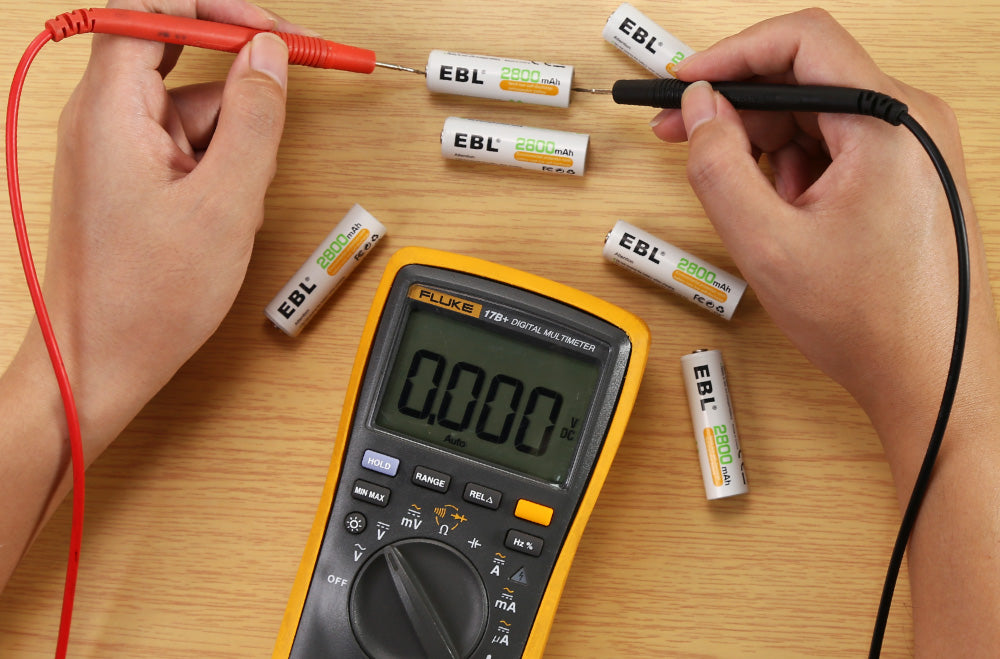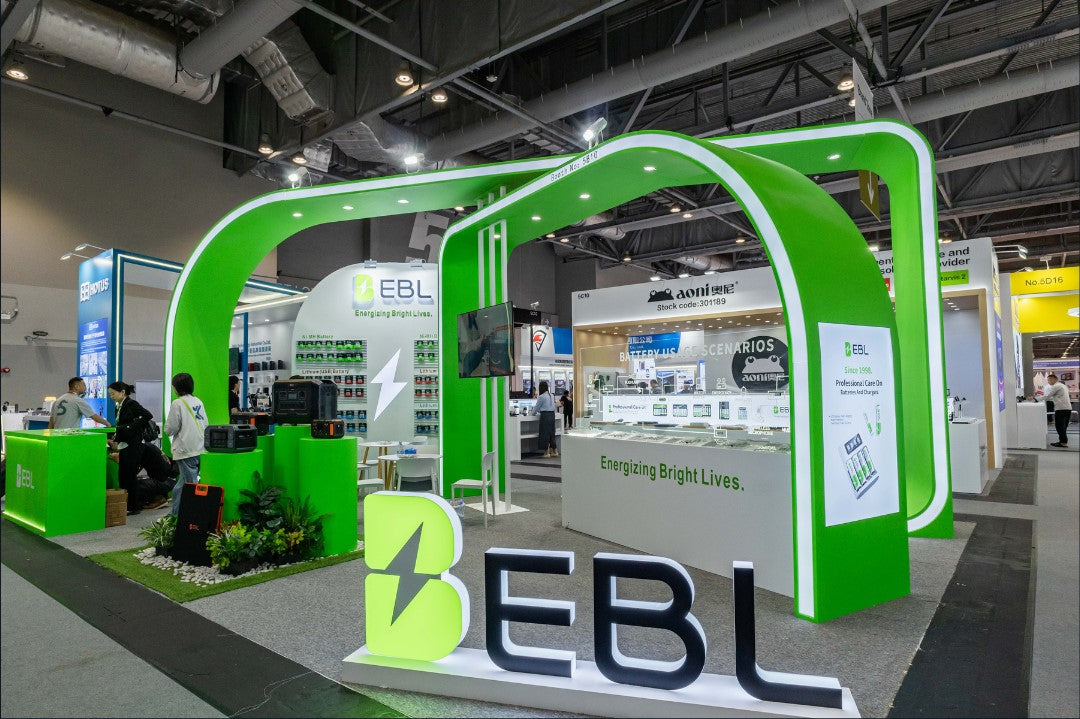Whether you are looking for AA, AAA or any size of domestic batteries, there are a number of options, and each has their uses.
Know Your Battery Technology
Use rechargeable or non-rechargeable batteries?
To know which battery you need, it is important to understand what is available to you. In both AA and AAA sizes, there are two distinct types of battery. These are rechargeable or non-rechargeable batteries.
Non-Rechargeable Batteries
These are the traditional, single use battery types that we all know and love. They are cheaper to buy than rechargeables, but unlike rechargeable batteries, once the charge is gone, that is it.
There are two types of single use battery commonly available.
1.Alkaline Batteries
Click here for EBL Alkaline Batteries.
Alkaline single use batteries are usually the cheapest option you will find, and are often packaged with low drain items like TV remotes, which work really well. They put out around 1.5 volts in use, although that can be as much as 1.6 volts when brand new, so are great for voltage sensitive applications too.
However, these batteries are not well suited to high drain devices where they can have a very short lifespan. In addition, if left in storage for a long time, they can leak, not just losing charge but emitting toxic material.
2.Lithium Batteries(Li-FeS2, Li-MnO2)
Click here for EBL Non-Rechargeable AA Lithium Batteries
The other common non-rechargeable battery type is Lithium. These should not be confused with rechargeable lithium-ion batteries, they cannot be recharged at all. They offer high energy density, meaning that are perfect for high drain devices such as cameras, radio control gear for drones etc., portable audio devices and more. With an output of 1.5 volts, they will meet most device needs, and that can be as high as 1.8 volts when they are new, avoiding any voltage related issues.
However, they cost more than alkaline batteries, and are usually the most expensive non-rechargeable batteries. As a result, they are not used in most household devices and are usually restricted to those high drain scenarios.
Rechargeable Batteries
As the name suggests, a rechargeable battery can be recharged when it runs low on power, giving it new life to power your gadgets. They tend to be more expensive than alkaline single use batteries, but not by a huge amount. If we consider that you can recharge one of these batteries as many as 1000 times before it needs replacing, they are much cheaper in the long run.
There are several types of rechargeable battery on the market, each offering a slightly different experience.
1.Nickel Metal Hydride Batteries (NiMH)
Click here for EBL NiMH battery
Often shortened to NiMH, Nickel metal hydride rechargeable batteries are the most common in use today. They provide a steady 1.2 volts, with up to 1.4 volts when fully charged. This can be an issue for voltage sensitive applications, but they are an economical option for most applications.
NiMH rechargeable batteries have a high capacity that makes them suitable for high drain devices such as cameras or wireless mice, with capacities ranging from 1000mAh to 2800mAh. However, they tend to lose charge over time if left unused, leaving you with batteries that need recharging just when you want to use them.
2.Nickel-Cadmium Batteries (NiCd)
Click here for EBL NiCd battery.
Nickel Cadmium, or NiCd, once reigned supreme in the world of rechargeable batteries. They offered impressive lifespans, able to be recharged a huge number of times, along with relatively low cost and a steady 1.2-volt output that worked in most situations.
They are particularly good in low temperatures, but because they are lower capacity (between 600mAh and 1000mAh), they have been surpassed by NiMH options today. In addition, their use of cadmium, a toxic element, made them a hazard and an environmental issue when disposing of them. You will rarely find them offered today.
3.Lithium-Ion Batteries (Li-ion)
Click here for EBL Li-ion battery, USB Li-ion battery.
Li-ion batteries bring several advantages over other types or rechargeable battery, including internal voltage regulation that delivers a consistent 1.5 volts throughout their charge. This allows them to be used as direct replacements for the non-rechargeable alternatives of Alkaline or Lithium, without requiring any alteration to equipment. They are often used to replace NiMH batteries too, as they have some advantages there as well.
Lightweight and with high energy density, they are great for high drain devices, and are often found in laptops and smartphones. They are energy stable too, and don’t lose much charge if left unused for a period of time.
However, the chemical makeup of these batteries means they need dedicated chargers that can’t be used for other battery types. They also cost more than other rechargeable batteries.
4.Lithium Iron Phosphate Batteries (LiFePO4)
Lithium Iron Phosphate batteries, often called LiFePO4, are another rechargeable battery option that puts out a steady 1.5 volts. This makes them ideal for replacing alkaline batteries and for use in voltage sensitive applications. They have an extended life cycle, accepting a large number of recharges while maintaining performance. This is some of the safest battery tech around too, making them a good choice in many applications.
However, they have a high cost compared to other rechargeable options, and tend to be difficult to find with few stores offering them as regular stock.
5.Nickel-Zinc Batteries (NiZn)
Click here for EBL NiZn battery.
The last type of rechargeable batteries commonly found is NiZn. These high-power batteries offer 1.6 volts in use, and as much as 1.65 volts when fully charged, so are idea for voltage sensitive devices that would otherwise be restricted to alkaline options.
With a significantly higher voltage output than NiMH batteries, they are a great option for situations where replacing single use batteries with rechargeable ones has led to problems of fast discharge with NiMH products.
At around 1500-2000 mAh capacity, they sit somewhere towards the low end of overall capacity, and combined with a high self-discharge rate that means they lose charge quickly when left unused, they require charging more often than other rechargeable battery options.
Whichever of these battery types you choose, there are some things to bear in mind with rechargeable batteries. A single charge won’t last as long as the charge from a non-rechargeable battery, so for power hungry devices remember you may need spare batteries if recharging will be impractical. Also, they don’t last forever. How long a rechargeable battery lasts depends on the technology used, but after a while, they will be unable to hold a full charge, and eventually degrade to the point where they cannot be used.
Spot the Difference - how to tell rechargeable and non-rechargeable batteries apart

When you open a device and see AA batteries, how can you tell if they are rechargeable or not? Recognizing the differences between rechargeable and non-rechargeable batteries is crucial in determining which type you need for your device.
If you’ve ever opened a drawer full of batteries, you know how similar they can look. Here’s how you can distinguish between them:
Clear Labeling
Manufacturers usually label rechargeable batteries with the word “Rechargeable.” If this label is missing, it’s a safe bet that the battery is not meant to be recharged. This labeling helps prevent the accidental charging of non-rechargeable batteries, which can be dangerous.
Chemical Composition
Look for specific terms on the battery label:
- Rechargeable Batteries: Labeled as NiMH (Nickel-Metal Hydride) or Li-Ion (Lithium-Ion).
- Non-Rechargeable Batteries: Labeled as Alkaline or Lithium (not to be confused with Li-Ion).
Energy Density and Durability
Different types of batteries have varying energy densities, which affect their longevity and suitability for different devices:
1.Alkaline Batteries
- Energy Density: High energy density, making them very durable for single-use. Ideal for low to moderate drain devices like remote controls and clocks.
- Usage: Best for devices that are used sporadically and require a steady, long-lasting power supply.
2.NiMH Batteries
- Energy Density: Lower energy density than alkaline but can be recharged many times. Suitable for high-drain devices like cameras and toys.
- Usage: Cost-effective for frequently used devices due to their rechargeability.
3.Li-Ion Batteries
- Energy Density: Highest energy density among common rechargeable batteries. Lightweight and maintains a stable voltage.
- Usage: Ideal for portable electronics like smartphones and laptops that require a compact and high-energy power source.
4.Lithium (Non-Rechargeable) Batteries
- Energy Density: High energy density, similar to alkaline batteries. Excellent for high-drain devices.
- Usage: Best for devices like high-powered flashlights and digital cameras where long-lasting, single-use power is needed.
Making the Right Choice
To choose the right battery, consider your device’s power requirements and usage frequency:
- For infrequent use and steady power needs: Non-rechargeable alkaline or lithium batteries are suitable.
- For frequent use and high power consumption: Rechargeable NiMH or Li-Ion batteries are more economical and efficient.
Understanding these differences ensures that you select the best battery for your needs, enhancing the performance and lifespan of your devices.
What battery should you use?
Why Choose Rechargeable Batteries?
Do you use your device frequently? If you find yourself replacing batteries often, rechargeable batteries are a smart choice. They may have a higher upfront cost, but you can recharge and reuse them many times, making them much cheaper in the long run. Devices like cameras, gaming controllers, and other high-drain gadgets benefit greatly from the convenience and cost savings of rechargeable batteries.
Why Aren’t Rechargeable Batteries as Long-Lasting?
Why doesn’t my rechargeable battery last as long as a non-rechargeable one? Rechargeable batteries typically have a lower initial energy capacity compared to non-rechargeable (alkaline or lithium) batteries. This means they might not last as long per charge. However, their ability to be recharged hundreds of times compensates for this, offering long-term savings and reduced environmental impact. Rechargeable batteries are ideal for devices that are used frequently and require regular battery replacement.
When Should You Use Non-Rechargeable Batteries?
Do you have low-drain devices? For applications such as smoke alarms, TV remotes, or wall clocks, non-rechargeable batteries make more economic sense. They provide a steady and long-lasting power source, perfect for devices that don’t consume a lot of power and don’t need frequent battery changes. Alkaline batteries, for example, are great for these low-drain applications because they have a high initial energy capacity and a long shelf life.
What’s the Best Option for Emergency Devices?
Need batteries for emergencies? Non-rechargeable lithium batteries are excellent for high-drain devices in emergency kits because of their long shelf life and reliable performance in extreme temperatures. They are lightweight, have a high energy density, and can operate effectively in both very high and very low temperatures, making them ideal for emergency flashlights, radios, and medical devices.
By considering your device’s power needs and usage frequency, you can choose the right battery type for optimal performance and cost efficiency.
Common Battery Problems
When choosing batteries, it's important to consider common issues such as voltage compatibility and device requirements. Here are a few specific examples:
Voltage Sensitivity
Example: Battery Doorbell
It may draw quite a lot of power when used, causing problems with how the bell works. You may find a rechargeable battery lasts a very short time, even as little as a couple of hours before it stops working.
This is an issue with voltage. In situations where the device is voltage sensitive, a standard non-rechargeable battery is better equipped. This is because these alkaline batteries out 1.6 volts, Lithium are even higher at 1.8volts, but a rechargeable battery may only provide 1.25 volts output. If the device is intended for a higher voltage, the rechargeable will be quickly depleted and cause operational issues.
High-Drain Devices
Example: Digital Cameras
Digital cameras are high-drain devices that can quickly exhaust batteries. Non-rechargeable lithium batteries are often preferred because they provide a consistent high voltage and longer run time. Rechargeable batteries, such as NiMH, may not perform as well because their voltage can drop more quickly under heavy load, resulting in shorter usage periods and more frequent recharging.
Temperature Sensitivity
Example: Outdoor Thermometers
Batteries in outdoor devices like thermometers are exposed to extreme temperatures. Non-rechargeable lithium batteries perform well in a wide range of temperatures, from very cold to very hot, maintaining their charge and functionality. Rechargeable batteries, especially NiMH, may have reduced performance in extreme temperatures, making them less reliable for such applications.
By understanding these common battery problems and considering the specific needs of your devices, you can make better choices to ensure optimal performance and longevity.
How to Charge your batteries

While there is a time and a place for both rechargeable and non-rechargeable batteries, most of the batteries you use today will be rechargeable. To make the most of these batteries, there are some things to remember when it comes time to charge.
- Always use a quality battery charger recommended for your battery type
- Don’t leave batteries in chargers too long. Once they are charged, take them out.
- Don’t let your batteries run completely flat before charging
- New batteries can take longer to charge, be patient
- When you are charging, check your batteries for damage and clean off any dirt
Importantly, remember that you should never try and recharge a non-rechargeable battery, there is a danger of explosion if you do. This is why you should always follow caution with your batteries, if you are not sure a battery can be recharged, then simply do not recharge it.





Leave a comment
All comments are moderated before being published.
This site is protected by hCaptcha and the hCaptcha Privacy Policy and Terms of Service apply.